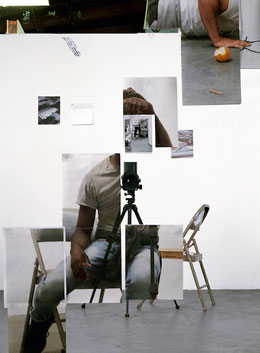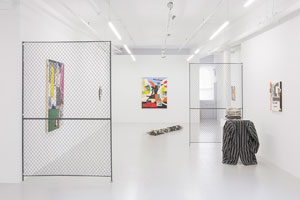The Well-Meaning Biennial
John Haberin New York City
The 2019 Whitney Biennial
Disembodied voices catalog your greatest fears or your worst political sins. Disembodied hands tinker endlessly with the simplest of things, in hope of finding peace.
Whether in anger or in pain, the 2019 Whitney Biennial looks for reassurance. It may be the most politically correct biennial ever, and it is definitely the youngest and most culturally diverse. It has few memorable images, few real people, few burning issues, and few departures from tired strategies. It dares you challenge its certainties, just as it dares you to dislike it. Yet that dare is a real engagement with the viewer, and it saves the museum from itself. Call it the well-meaning biennial. 
Hands and voices
Well-meaning may not sound like a compliment, nor should it. The road to art is not often paved with good attentions. The 2017 Whitney Biennial was political, too, but it all but drowned in controversy over a painting by Dana Schutz. In representing the death of Emmett Till, she had the guts to speak out. Still, many complained, that meant a white woman speaking for others. This biennial is determined not to allow that. Decades after art and criticism called sincerity into question, it is all about the most sincere of voices speaking for themselves.
The voices divide neatly enough between anger and pain, but the two can easily go together. Marcus Fischer may sound angry about racism, sexism, and more, but he merely asked his friends to express their greatest fears for life under Donald J. Trump. His Words of Concern emanates from a small radio with a huge antenna, as if crying for rescue from the wilderness. And the hands belong to Ilana Harris-Babou, at the showroom of Restoration Hardware in the Meatpacking District, just blocks from the new Whitney Museum. She is commenting on consumerism, faux heirlooms, and all that has kept African Americans from a home. She holds out hopes of restoration for a people or the soul, except when she does not.
Sometimes, though, anger and pain stand blatantly apart. Christine Sun Kim runs through every possible indignity to the deaf, whether callous or, yes, well-meaning, and her charcoal is just as cartoonish. Another voice belongs to David Byrne, who narrates a video about tear gas, by Forensic Architecture in conjunction with Praxis Films and Laura Poitras. Their litany of harm hammers home the word danger. A more oblique reminder of tear gas comes in wall paintings by Pat Phillips of a fist and a literal hammer. Phillips speaks to the horrors of Louisiana State Penitentiary, or Angola, but the paintings, including a full wall set behind a wood fence, seem oddly cheerful.
Why tear gas, and why a British collective at a museum of American art? For one thing, the video becomes more vivid as it turns to clouds of gas and sharply angled victims. More to the point, a museum board member, Warren B. Kanders, has made a comfortable living from military hardware. Nearly half the biennial artists have joined demands that he resign—which he did in July, although not before eight of the artists had threatened to withdraw their work. Credit the Whitney with including a protest against itself. It sticks up for curatorial and artistic freedom, even if the artists were no longer sure that they belonged.
More historical certainties turn up in almost every medium. Tomashi Jackson uses plastic bags and an awning to evoke the African American labor and loss that gave rise to Central Park. Far less allusively, Jeanette Mundt paints press images of the women's Olympics. Some artists can never get enough heroes. Close by, Kota Ezawa turns the kneeling of NFL stars into animation, accompanied by ever so respectable music. Rather than bringing something to events, he might as well be making them accessible to children.
As for pain, more hands belong to Elie Ga in multichannel video and slides. She tinkers with small stones and other detritus from the sea, while her voice links ocean currents to both science and Greek myth. Still other hands and other amalgams of nature and culture belong to Laura Ortman, who plays her violin outdoors beside a dancer. Harris-Babou may mean only irony, but she really does hope for My Soul Remainder. Uncertainty becomes a story in itself for Gala Porras-Kim, who tries to decipher an Olmec stele. Between graphite, a pockmarked sculpture, and a Plexiglas mobile, she finds instead alternatives.
Not bodies, but humans
Art thrives on uncertainty, and so do I. Still, the contrasting approaches both amount to political art, and both, like another state of the art survey in drawings, prefer personal responses to specifics. The last biennial ran to big paintings, depicting people as groups and types. Painting here runs more to individuals and myth.  Jennifer Packer places them against broad red washes, in search of "not bodies, but humans." Like so many others, she is out to recover history but not to be trapped in it.
Jennifer Packer places them against broad red washes, in search of "not bodies, but humans." Like so many others, she is out to recover history but not to be trapped in it.
Keegan Monaghan recovers a lost innocence in household objects, Troy Michie has his chronicle of racism and high style, and Calvin Marcus underscores the good cheer and artistic conservatism with an upside-down snowman and the view out a windshield. He could be Alex Katz with a greater sense of humor. Others settle for bright colors and the barest hint of a story, with a mother crossing a landscape (for Janiva Ellis), Miami's Little Haiti (for Eddie Arroyo), covers of art magazines (for Marlon Mullen), and couches and cars on the move (for Walter Price). Lithographs by Alexandra Bell, who was no more than a child in 1989, blacken and highlight old Daily News pages about the Central Park Five—and Trump's racist ad calling for the death penalty. They take on new relevance, especially in light of the theme of censorship in contemporary art from China. Still, you have seen that erasure before, time and again, from Sarah Charlesworth and Jenny Holzer to Titus Kaphar.
The personal and the political join forces more effectively in three dimensions. Ragen Moss brings his materials alive with resin torsos. So does Brian Belott with a cross between a freezer cabinet and a vending machine. Bubbles churn through liquid in boxed photographs of American landmarks by Josh Kline. They may even make a point of being derivative. Iman Issa turns museum artifacts into abstract sculpture, to question ethnography while delighting in art.
Photographs may do best of all at combining questioning with self-questioning. Elle Pérez captures transgendered faces as visibly "pushing the body." Paul Mpagi Sepuya once again has his stunning but deliberately self-effacing LGBTQ photography, but he is no longer alone. He comes in a whole room for hide-and-seek studio portraits. More slickly, John Edmonds poses queer blacks with African totems, trading sensuality and mind games for affirmation and shining, flattering skin. Every one of these is out for self-assertion, but the best know when to back off. Everyone, too, has a gendered or ethnic identity.
For better or worse, white males born in the United States are few and far between. Still, every so often identity becomes as slippery as Porras-Kim's Mesoamerican inscriptions. Eric N. Mack asks that Gee's Bend quilts replace the American flag, amid Native American hangings by Jeffrey Gibson, but only by adding imagery from the present. Joe Minter, Maia Ruth Lee, and Tiona Nekkia McClodden represent the New South, Nepal, and Afro-Cuban tradition, but with scrap metal akin to that of Melvin Edwards and simple tools. Curran Hatleberg may have the last word, though, with rural America. Black and white, his subjects may look at ease, but their faces never meet, and a car suspends overhead as if over a chasm.
Brendan Fernandes does attain a degree of peace, in sculpture and performance. Dancers move slowly in and out of hanging ropes, a Minimalist steel frame, and a central cage. They work between openness and confinement, mastery and submission, self-discovery and community. Not that they step altogether outside identity politics. Fernandes is from Kenya, and he sees the discipline of the dance as akin to S&M. Nothing in this biennial is innocent—except for much of its art.
What is the point?
The biennial's contrasting approaches have something else in common as well, the perils of youth. They reflect the certainty of young adults demanding their place in the world. They reflect, too, the fears that they will never reach it. Three quarters of the seventy-five participants are under forty, far more often from Lower East Side galleries than Chelsea. If much of what they produce seems naive and predictable, you can understand. This generation, too, has to work its way through Robert Rauschenberg and assemblage or Andy Warhol and popular culture—as if encountering them for the very first time.
They cannot help softening their precedents at that, as part of the dreaded well-meaning. Carissa Rodriguez replays the "Pictures generation" twice over. She picks up Sherrie Levine with a copy after Constantin Brancusi—and Louise Lawler, who photographed art in the homes of monied collectors as if it belonged nowhere else. To add to the ironies, Levine called her copy Newborn. Yet Rodriguez ends up turning the devices of one artist against the other. Her moving camera spends a day and night with Levine's work, and it becomes less a critique than a luxuriant tribute.
Here artists in their fifties count as elder statesmen and the very guardians of culture. Wangechi Mutu has his Sentinels at that, bringing a gaunt presence to the cracked surfaces of Medardo Rosso and Magdalena Abakanowicz, just as she will soon bring her mythic women to the Met. Simone Leigh still places her women in skirts of dried reeds between blindness and freedom.  Nicole Eisenman, too, conveys wrenching emotions and a thorough break with formalism. As the biennial opened, her sculpture endured the worst of a color rain on a museum terrace. It hardly matters if you cannot say for sure the role of each figure in her Procession.
Nicole Eisenman, too, conveys wrenching emotions and a thorough break with formalism. As the biennial opened, her sculpture endured the worst of a color rain on a museum terrace. It hardly matters if you cannot say for sure the role of each figure in her Procession.
Diane Simpson rounds out the fifty-somethings with a more disciplined cultural crossing. Her reliefs draw on different kinds of clarity—from the Amish, art deco, and Samurai armor. The older artists are also reminders of how much the curators, Jane Panetta and Rujeko Hockley with Ramsay Kolber, leave out. Abstract painting, bold representation, and the space between them never once appear. Photography still mostly gets along without photocollage, sculpture does not often become installation, and a "prayer rug" by Nicholas Galanin displays the pixels of old-time TV. Everything is more or less conceptual, but nothing quite counts as conceptual art.
The show cannot help raising a nagging question at that: what is the whole point of a Whitney Biennial? Should it be just one more choice of emerging artists, on top of "Greater New York" at MoMA PS1, a New Museum Triennial, "Open Call" at The Shed, and the occasional rundown at the Studio Museum in Harlem? Should museums be anointing the next big thing? Can a biennial instead represent art now as a whole or at its very best? And how can it aspire to either one without far older living artists—and that includes gays, outsiders, blacks, and women?
Should it stick to a theme, at the risk of stories that no one but the curators can hear, or pick winners, at the risk of ending up with mostly losers? This biennial has an uneasy mix of all of the above, just as Augustina Woodgate cannot quite synchronize a room of clocks. Credit it with discoveries—or forget it before it is done. In the end, it is left with decent, well-meaning art. It is offering reassurance not just to the artists, but to the viewer as well. It may not make much of an impact, but for once the Whitney Biennial is kind of fun.

The 2019 Whitney Biennial ran at The Whitney Museum of American Art through September 22, 2019. Other reviews look ahead to the 2019 Biennial, 2022 Biennial, and 2024 Biennial—or back to the 1993 Biennial, 1997 Biennial, 2000 Biennial, 2002 Biennial, 2004 Biennial, 2006 Biennial, 2008 Biennial, 2010 Biennial, 2012 Biennial, 2014 Biennial, and 2017 Biennial. As a further twist, the Whitney's former board member announced in June 2020 that he was getting out of the business of tear gas.




